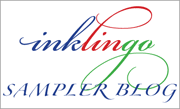 Uses Collection # 2.
Uses Collection # 2.This block is one that I had to make. My first name starts with a T as does that of my DH. Very important block :-)
Martha's block on top, Elly's block below.
Use the Flying Geese method, found on p. 10-11 of the Triangle Tips.

Fabric 1 (background)
Two 3.25" squares for the Geese
3.5 x 6.75 for printing 2" HST
One 2.5" square
Fabric 2 (focus)
4.5 x 8.5" for printing 1" HST
3.5 x 6.75 for layering with the BF 2" HST
From p. 62 of Collection # 2, pick the ink-colour that will work best with your fabric.
Cut a 4.5 x 8.5" piece of fabric and same size of freezer-paper.
Iron freezer-paper to the front / right side of the fabric.
Print 16 HST with a finished (square) side at 1"
From page 70 of Collection # 2, pick the ink-colour that will work best with your fabric.
Cut a 3.5 x 6.75" piece of fabric and same size of freezer-paper.
Iron freezer-paper to the front / right side of the fabric.
Print 4 HST with a finished (square) side at 2"
Press those towards the background-fabric.
Layer the two fabrics that are each 3.5 x 6.75", right sides together.
Sew on the diagonal (dotted) lines.
Cut on all the straight (whole) lines.
Iron your HST to the light / background-fabric.
 Make 8 Flying Geese, usingLinda's directions in the the Triangle Tips file, p.10-11. You will use the two 3.25" squares of Background fabric and the 16 1" HST for this.
Make 8 Flying Geese, usingLinda's directions in the the Triangle Tips file, p.10-11. You will use the two 3.25" squares of Background fabric and the 16 1" HST for this.Join the Geese in pairs, so they fly the same way.
Lay out the (now) 9 bits, to form the block
Join as you would a 9-patch.
OR, you could go to town, and make the T's in two different colours. There's a bit more printing involved here, but Linda's method of making Flying Geese actually works well for this one.
 Two-colour version.
Two-colour version.Fabric 1 (background)
Two 3.25" squares for the Geese
3.5 x 6.75 for printing 2" HST
One 2.5" square
Fabric 2 (focus A)
4.5" square for printing 1" HST
3.5" square for layering with the BF 2" HST
Fabric 3 (focus B)
4.5" square for printing 1" HST
3.5" square for layering with the BF 2" HST
 Start making the flying geese exactly as directed, using the same fabric HST to make the first part.
Start making the flying geese exactly as directed, using the same fabric HST to make the first part.When they are cut apart, and have been pressed, use HSTs from the other focus-fabric to make the second round.
 This will give you Geese with two different colours of corners, and they will be mirror image. This is as it should be.
This will give you Geese with two different colours of corners, and they will be mirror image. This is as it should be.Lay out Geese, that have same focus-fabric to the same side, and join them in pairs, making sure the Geese turn the same way.
Lay out your block.
Join as you would a 9-patch.
Press.
Finished !
If you know of patterns or books that uses this block in this size, please let me know, and I'll make links to each of the ones I'm aware of. miz_pal (at) hotmail (dot) com.
Barbara Brackman's "Encyclopedia of Pieced Quilt Patterns" # 1662a
And here's an interesting story about the Double-T block, that Dorothy shared (and thank you for that, Dorothy) :
You may know that before women had the vote in the US, many expressed their political beliefs through their quilts. Blocks like Tippecanoe, Whig Rose, 54-40 or Fight, etc. all expressed the quilter's views on issues of the day. The T-block has the same significance.
In the mid 19th century, a huge reaction to the ubiquity of liquor in American life arose. The Temperance movement grew, and the T in this block stands for Temperance.
Eventually women in the US won the right to vote, and shortly after that, Prohibition (the Constitutional amendment outlawing the sale of liquor) became law.





















